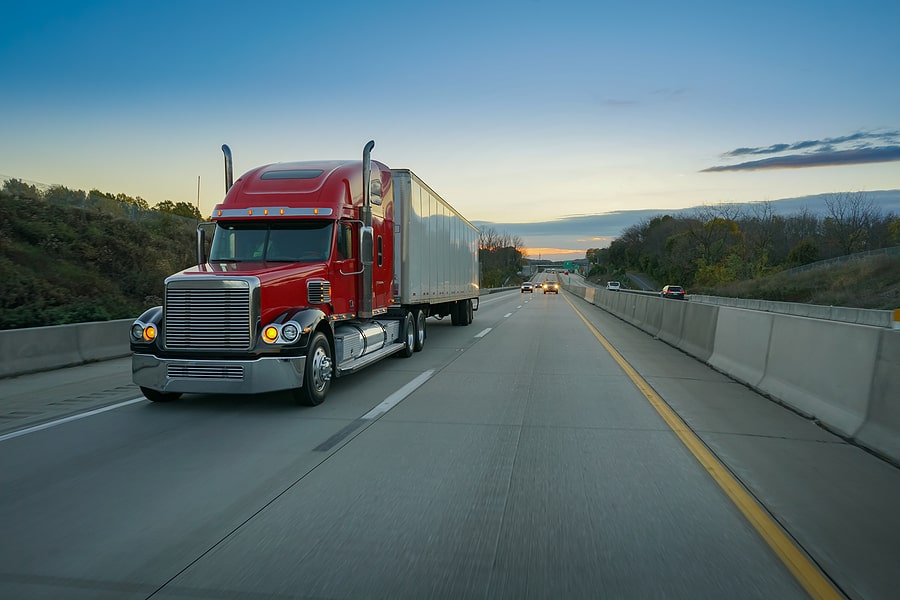You check your side-view mirror and see a tractor-trailer truck appear behind you out of nowhere. Watching this truck approach at a high speed gives urgency to the warning that “objects in mirror are closer than they appear.”

The Insurance Institute for Highway Safety reports that passenger vehicle occupants account for most deaths in crashes involving large trucks. In a recent year, large truck accidents resulted in over 4,100 deaths, and people in passenger vehicles comprised 67 percent of those deaths. Your vehicle will be no match for a truck that could weigh 20 to 30 times more than your car.
Several factors may contribute to accidents involving tractor-trailer trucks.
The Hazardous Combination of Speeding, Long Braking Distance, and Dangerous Road Conditions
The National Highway Traffic Safety Administration reports that over 21 percent of truck drivers in fatal accidents had at least one prior conviction for speeding. When truckers exceed the posted speed limit or drive too fast for conditions, they could trigger a high-impact crash.
Speeding aggravates accident risk because, according to the Insurance Institute for Highway Safety (IIHS), tractor-trailers carrying cargo may travel 20 percent to 40 percent farther than cars before coming to a stop. The Federal Motor Carrier Safety Association explains that a truck with a full load driving in good road conditions at 65 miles per hour may need up to two football fields to come to a standstill.
Semis take longer than cars to stop in the best of conditions, when traveling on a level stretch of highway under clear skies. Less-than-perfect road conditions may cause a semi to need an even longer stopping distance. Snow-covered, icy, or wet roads may lengthen braking distance, and foggy conditions may limit a trucker’s ability to see ahead and brake in time to avoid an accident.
Ramps and curves may also lead to crashes or rollovers if trucks fail to adjust their speed for conditions. IIHS explains that the high centers of gravity on large trucks increase their rollover risk, especially on curves and ramps. Passenger vehicles face danger when they find themselves in the path of an out-of-control tractor-trailer.
Trucking Industry Demands Contribute to Driver Fatigue
According to the U.S. Department of Transportation, in a recent year, at least one driver-related factor contributed to 32 percent of large truck fatal crashes. While speeding was the most common factor, other driver behaviors (like drowsy driving) accounted for crashes.
You may remember the 2014 accident in which a Walmart truck driver crashed into a limo van carrying comedian Tracy Morgan. The National Transportation Safety Board concluded that the truck driver was traveling 20 miles per hour over the speed limit and had been awake for over 28 hours before the accident.
The New York Times interviewed experts who believe that reports may underestimate fatigue as a cause of commercial truck accidents. A truck industry veteran estimates that approximately 70 percent of semi crashes involve tired drivers. IIHS explains that truck drivers’ schedules and job demands may lead to fatigue. The trucking industry requires irregular schedules, long work hours, unpaid waiting times at warehouses, and pressure to meet deadlines. These conditions may leave drivers sleep-deprived and rushing to make up time on the road.
While the Federal Motor Carrier Safety Administration (FMCSA) imposes hours of service limits on truckers to control the risks inherent in drowsy driving, drivers and trucking companies may sometimes skirt these rules to meet schedules. Electronic logging devices are now mandatory to minimize the risk of rule-bending.
Distracted Driving May Impair Driver Reaction Time
Distracted driving may lead to serious accidents when truck drivers engage in activities that impair their reaction time. While activities like eating, drinking, reading a map, or programming a GPS device can cause drivers to divert their attention from the road, texting heightens the risk of distracted driving.
According to FMCSA, drivers who text take their eyes off the road for an average of 4.6 seconds. At 55 miles per hour, in 4.6 seconds, the driver looks away from the road while traveling a distance longer than a football field. FMCSA warns that drivers of large vehicles who text while driving are over 23 times more likely to cause a crash, experience a near-crash, or unexpectedly leave their lane. Even talking on a handheld phone may pose a cognitive distraction.
Risks of Underride Accidents May Outmatch Automobile Safety Systems
The National Highway Traffic Safety Administration reports that 22 percent of two-vehicle fatal crashes with large trucks resulted from a passenger vehicle hitting the rear of the truck, and 16 percent of two-vehicle fatal crashes resulted from a vehicle colliding with the side of the truck. In these rear or side collisions, ground clearance under semis can lead to underride accidents (where the vehicle slides under the tractor-trailer). In an override accident, a truck may ride over a car.
The U.S. Government Accountability Office (GAO) explains that the height difference between a large truck and passenger vehicle may result in passenger compartment intrusion in a crash. Safety features like airbags and crumple zone sensors may not engage in these impacts, leading to serious injuries or even fatalities.
The GAO believes that crash investigators may misclassify underride accidents, resulting in underreporting.
The GAO recommends:
- A uniform definition of underride crashes
- Annual inspections of rear underride guards
- Research into side underride guards
While federal regulations require rear guards on most large trucks, these guards are not subject to an annual inspection. Regulations do not currently require side or front guards.
Tractor-Trailers May Pose Mechanical and Improper Loading Risks
IIHS explains that faulty or improperly maintained equipment may contribute to truck accidents. A rushed trucker may not take the time for an adequate safety inspection before hitting the road, and an overlooked or inadequate inspection may result in tire blowouts or worn brakes. Even with new technologies, brake systems need ongoing high-quality maintenance.
Truckers must also take the time to balance and secure their cargo. FMCSA requires truckers to secure their cargo loads and other contents to minimize the risk of items falling from the truck or shifting in a way that threatens the truck’s stability and the safety of passenger vehicles in the truck’s path.
Trucking Companies Should Adopt Technologies to Minimize Accident Risks
IIHS describes new crash avoidance technologies that may help mitigate the likelihood or seriousness of a truck accident. However, trucking companies have not yet embraced all these technologies.
For example, electronic stability control may help stabilize a truck to help prevent jackknife or rollover accidents. Other technologies include lane departure warnings, blind spot detection alerts, and forward collision warning/mitigation systems. Trucking companies could also adopt technology that monitors sleepy drivers.
Until full implementation of crash avoidance technologies and other safety measures in the trucking industry, passenger vehicle occupants could remain at risk when sharing a road with tractor-trailers. If you or a loved one has suffered the serious consequences of a tractor-trailer accident, contact an experienced truck accident lawyer.



